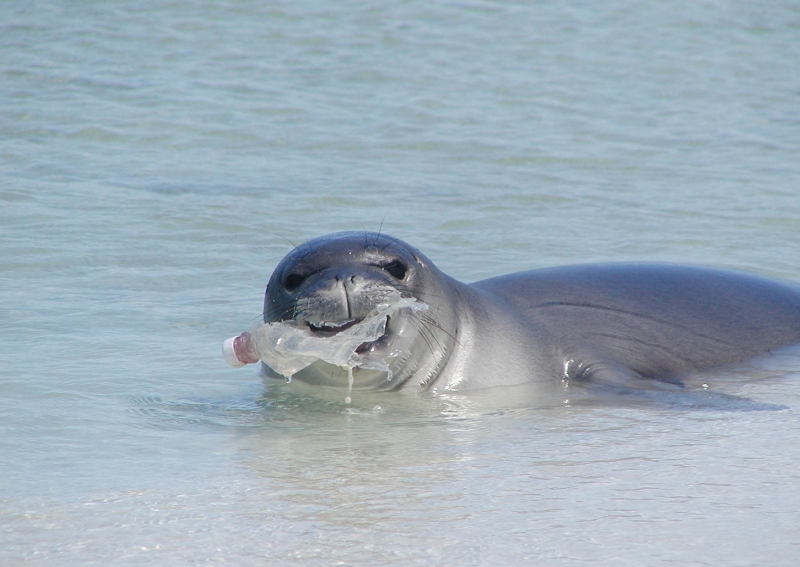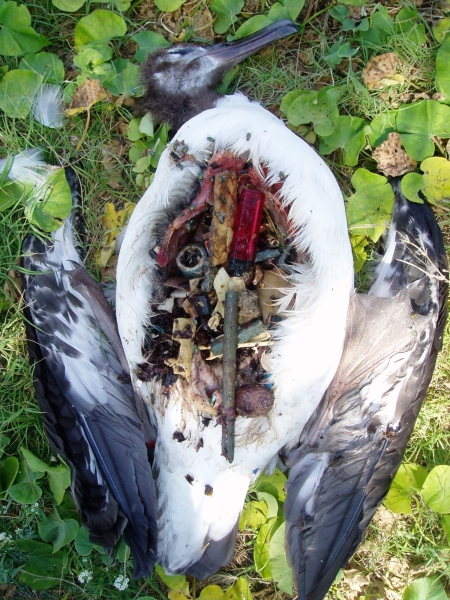Join the NOAA Marine Debris Program as we celebrate National Ocean Month. This week’s theme is Ocean Science. Do we know if animals snack on plastic? Dive into the science of plastic ingestion to learn more.
Millions of tons of debris enter the marine environment each year, including our trash and damaged fishing gear, and can be found at the surface of the water, down to the deepest parts of the ocean. Many marine debris items, especially plastics, are small enough to be ingested, or eaten, by wildlife, an issue of growing concern for the health of hundreds of marine animals. Animals may directly eat marine debris, or it may be consumed with prey that already has a belly full of marine debris.

Some marine animals are more likely to eat plastic than others. The characteristics of plastic debris, such as color, size, or shape, can attract certain types of wildlife. The amount of marine debris in a certain area and the feeding behaviors of different animals can play a large role in which animals are more likely to eat marine debris. Some animals filter water to consume their food (e.g., baleen whales, mussels, oysters), and can easily eat plastic, most commonly in the form of microplastics, or plastic pieces smaller than 5 mm. Other animals (e.g., birds, fish, turtles, toothed whales) actively search for and capture their food and may accidentally ingest plastic marine debris while eating their prey, which may have also eaten plastic.
Some species, such as sea cucumbers, even prefer to eat plastics and will choose to feed on them over their regular food. Invertebrates, or animals without a backbone, not only ingest microscopic plastic pieces, but they can also increase the breakdown of plastic marine debris. For example, some invertebrates dig into foam floats, which may cause tiny pieces of plastic to break apart and produce enormous amounts of microplastic debris!

Research highlighted in a NOAA report reviewing marine debris ingestion by wildlife, showed that birds, marine mammals, and turtles are more likely to ingest marine debris over fishes, including sharks. Fishes and sharks are less likely to ingest debris as they become older and larger and become more efficient at capturing their prey, which makes them less likely to accidentally consume debris while hunting for food. Research has confirmed that all seven species of sea turtles have eaten debris, as well as an estimated one-third of all sea bird species. Many marine mammals are also known to eat debris, ranging from microplastics to plastic sheets and bags, but are harder to study because of laws protecting these species.

When an animal eats plastic marine debris, it can be difficult to see the damage it does to their bodies. Debris can block or tear the digestive system of an animal, as well as cause problems for the way their body functions by affecting their nutrition and development, or even cause infections. Research has shown that sharp objects and sheet plastic, such as single-use plastic bags and plastic packaging, appear to cause the most damage to larger marine wildlife in the shortest amount of time. After an animal swallows debris, it can feel full, which might keep them from eating and getting the nutrients they need from food. Marine debris and the chemicals in plastics can also impact the function of an animal’s immune or reproductive systems, but this is difficult to monitor on marine wildlife.
Unfortunately, the effects of marine debris ingestion are not very well understood. Scientists are working to better understand how often wildlife ingests marine debris, as well as the ways it impacts the health of animals and their communities. Luckily, you can do something to help! Since marine debris is created by humans, we are also the solution. Learn how you can help reduce marine debris in our ocean and Great Lakes by making meaningful changes to the amount of waste you produce, and cleaning up your local environment.
